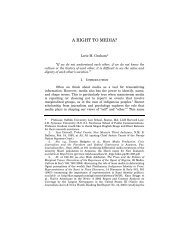The Right to Dignity Rex D. Glensy - Columbia Law School
The Right to Dignity Rex D. Glensy - Columbia Law School
The Right to Dignity Rex D. Glensy - Columbia Law School
Create successful ePaper yourself
Turn your PDF publications into a flip-book with our unique Google optimized e-Paper software.
120 COLUMBIA HUMAN RIGHTS LAW REVIEW [43:65<br />
Nevertheless, recognizing the right <strong>to</strong> dignity as a substantive<br />
legal right would certainly represent a major change in perspective,<br />
at least as it concerns reading the Constitution as merely an array of<br />
negative rights. This type of change has already been advocated for<br />
some time, as commenta<strong>to</strong>rs have argued for a more affirmative read<br />
of constitutional rights. 251 However, as for the second dimension of<br />
positive dignity rights, that which grants a private right of action <strong>to</strong><br />
dignitary injuries, this change, as demonstrated above, would only be<br />
marginal. Regardless of how little or much change the American<br />
system would undergo through this kind of recognition of dignitary<br />
rights, any change always counsels caution, and adopting this view of<br />
a right <strong>to</strong> dignity is something that could only occur through the<br />
passage of a somewhat long period of time. Indeed, the abstract<br />
solidarity between people expressed by the positive rights approach <strong>to</strong><br />
dignity occurs, as with all constitutional rights, “only when the<br />
principles of justice have penetrated more deeply in<strong>to</strong> the complex of<br />
ethical orientations in a given culture.” 252 Thus, the most probable<br />
outcome would be that even if there were a concerted movement<br />
<strong>to</strong>wards recognition of an explicit right <strong>to</strong> dignity, it would most likely<br />
take the form of one of the three approaches discussed below. 253<br />
B. Background Norm – <strong>The</strong> Negative <strong>Right</strong>s Approach<br />
<strong>The</strong> vast majority of rights delineated by the United States<br />
Constitution are unders<strong>to</strong>od as negative. This concept embodies a<br />
noninterference norm, whereby the government is required “<strong>to</strong><br />
abstain from denigrating (rather than requiring governments <strong>to</strong><br />
Bundesverfassungsgericht [BVerfGE] [Federal Constitutional Court] 1979, 50<br />
BVerfGE 256 (Ger.) (urns).<br />
251. See, e.g., Robin West, <strong>Right</strong>s, Capabilities, and the Good Society, 69<br />
Fordham L. Rev. 1901, 1911 (2001) (advocating a positive dimension <strong>to</strong> the Equal<br />
Protection clause); Susan Bandes, <strong>The</strong> Negative Constitution: A Critique, 88 Mich.<br />
L. Rev. 2271 (1990).<br />
252. Jürgen Habermas, Prepolitical Foundations of the Democratic<br />
Constitutional State?, in <strong>The</strong> Dialectics of Secularization: On Reason and Religion<br />
19, 34 (2006).<br />
253. It is important <strong>to</strong> note that adopting the positive rights approach <strong>to</strong><br />
the right <strong>to</strong> dignity would also most likely result in the adoption of the negative<br />
rights approach explained below, although the reverse is unlikely <strong>to</strong> be true. See<br />
generally Deryck Beyleveld & Roger Brownsword, Human <strong>Dignity</strong> in Bioethics<br />
and Biolaw 68 (2001) (explaining that human dignity, if placed within a context of<br />
morality alone, may not succeed).















